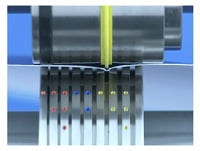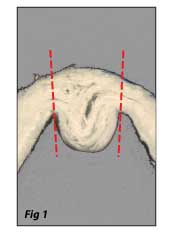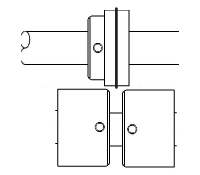For something with just two sides to it, it’s amazing the hundreds of questions that can arise. We are of course, referring to paper. There’s a good chance that some of what you’ve found to be true about printing and finishing paper is counter-intuitive. For instance, the simple question, ‘Which side of the paper should I score on my folding machine?’ falls into that camp.
The good news is you have a 50% chance of guessing right! Yet if you guess wrong, you can end up struggling needlessly. The real answer is a more down to earth and practical, “It depends.” But there is an easy way to figure out what to do when faced with a folding job that requires scoring.
Start by focusing on the result. What is it that you are trying to accomplish? Then you work backwards to determine which machines and procedures are best suited for that purpose. We’ll explain by reviewing the two most common scoring and folding scenarios you’re likely to encounter in your bindery department.
 Scenario #1 - Folding without fiber cracking. If this is the result you are after, then you will need to do three things:
Scenario #1 - Folding without fiber cracking. If this is the result you are after, then you will need to do three things:
- Use a Technifold EZ Fit or Fast Fit Tri-Creaser on your folding or scoring machine, Spine Creaser on your cover feeder or Spine & Hinge Creaser on your perfect binder
- Run the male side of the tool on the outside of the folded piece
- Crease one sheet at a time.
 A creasing tool, such as our Tri-Creaser, will compress the paper into a female channel as shown. Simply put, this de-laminates the sheet internally (diagram at right) and creates a paperboard hinge. The delamination relieves the internal pressures of folding and thus eliminates the fiber cracking that would normally occur. You can read more detail about creasing paper versus scoring paper here in a previous Bindery Success Blog article.
A creasing tool, such as our Tri-Creaser, will compress the paper into a female channel as shown. Simply put, this de-laminates the sheet internally (diagram at right) and creates a paperboard hinge. The delamination relieves the internal pressures of folding and thus eliminates the fiber cracking that would normally occur. You can read more detail about creasing paper versus scoring paper here in a previous Bindery Success Blog article.
Of course there are exceptions to these guidelines which we’ll cover below.
Scenario #2 - Folding where fiber cracking is not an issue. Typically this is brochure and signature work, consisting of multi-panel right angle work. In these cases you are trying to make two or more sheets of paper fold consistently where you want it to. This is done by scoring, which we define as any technique that weakens the paper along the fold line to assist in folding. It includes all types of rotary mechanical devices as well as wet-scoring, in which a needle applies a thin line of liquid along the fold line.
Mechanical scoring tools will normally have the male running on the inside of the folded piece for jobs like this. Fiber cracking is usually not an issue for this type of work. The bigger issue is getting the brochure to fold consistently and accurately. This is accomplished by fine tuning the score for the stock and sequence of folds.
 Note: Creasing Tools can be used for both creasing and scoring. Many scoring tools, however, such as those without female channels, are not capable of producing a true crease. One popular example (drawing) is the steel score blade pushing the sheet between two steel collars or against a rubber counterpart. It can produce a great score but it can’t crease. The paper will not de-laminate internally and thus will probably not eliminate a fiber cracking problem. For those of you whom already own Technifold Tri-Creasers, be sure to ask about our Nylon Creasing Ribs which are made of a harder material than our traditional style creasing ribs and our great for laminated sheets, brouchure and signature work.
Note: Creasing Tools can be used for both creasing and scoring. Many scoring tools, however, such as those without female channels, are not capable of producing a true crease. One popular example (drawing) is the steel score blade pushing the sheet between two steel collars or against a rubber counterpart. It can produce a great score but it can’t crease. The paper will not de-laminate internally and thus will probably not eliminate a fiber cracking problem. For those of you whom already own Technifold Tri-Creasers, be sure to ask about our Nylon Creasing Ribs which are made of a harder material than our traditional style creasing ribs and our great for laminated sheets, brouchure and signature work.
Scenario #3 - The Exceptions. Naturally the real world likes to mix things up a bit, especially if we think we have something figured out. Conventional creasing wisdom dictates that creasing only works on a single sheet of paper, with the male hitting the outside of the fold.
We discovered in practice, however, that with some 8pp and 12 pp right-angle signatures it was indeed possible to eliminate fiber cracking while “creasing” 2 or 3 sheets simultaneously. We're referring to the type of signature with one or two folds in the main parallel section, a score on the spine and the final fold in the right angle.
Technically, it’s not exactly a “crease” when you do a creasing operation on two or more sheets because the paper isn’t always de-laminated in true creasing fashion. And you won’t get the bead you normally see on the inside of a real crease. But the end result is that fiber cracking can indeed disappear on the spine of the signature.
It’s usually limited to about 6pt paper and typically the male will be hitting the outside of the fold. Having said that, we still urge you to experiment with the male on both sides of the sheet. You may find that the conventional score with the male on the inside will work just fine.
If fiber cracking remains after trying this, the best solution is to separate an 8 pager into two 4’s or a 12 pager into a 4 page and an 8 page signature. Then crease the cover sheet as described above (male into the outside) and score the 8 pager.
To sum up our answer to the question of which side of the paper to score:
- If fiber cracking is an issue, use a creasing tool with the male on the outside.
- If fiber cracking is not an issue on brochure or signature work, score with the male on the inside.
- For light signature work on 8’s and 12’s, experiment both ways and then run as separate signatures if needed.
In the bindery we’re all about fast results so if you have something that works for you, stick with it! If on the other hand you are struggling, you might find relief by simply trying the other side of the sheet.
Hundreds of bindery operators have shared countless variations with us on the creasing and scoring themes mentioned here. What we’ve learned from these conversations is there is almost never one single right or wrong answer to any given problem. It all depends…even when you have a 50-50 chance.

